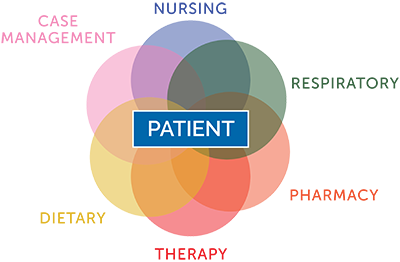Transitional Outcomes
We provide critical care services to our patients in the communities we serve. We often see patients who are recovering from disabilities caused by injuries, illnesses, or chronic medical conditions.
Transitional Outcomes
Modeled after national best practices, our Transitional Outcomes Program (TOP) is a patient-centered service designed to increase patient safety and reduce readmissions to acute care facilities.
Our program helps our patients move between healthcare practitioners, settings, and home as their conditions and care needs change. We use a collaborative, interdisciplinary approach to provide early identification and assistance with transitional needs of specific patient populations.
Patient engagement, education, and empowerment are integral to our program’s success.
How TOP Works
Patients at risk for readmission can be referred to the program at any time during his or her hospital stay by any member of our interdisciplinary team.

Once a patient is identified for TOP, members of our interdisciplinary team work together daily with the patient and family members to help reduce or eliminate risk factors for readmission. There are a variety of risk factors that are considered. These may include but are not limited to, medications taken incorrectly, lack of mobility, bowel and bladder issues, and inability to procure needed supplies and services.
We follow patients for a minimum of 30 days post-discharge to ensure appropriate and effective community reintegration.
TOP Components
Key components of TOP include:
- Early and ongoing education and intervention
- Validation of patient/family understanding of critical components to prevent readmission
- Follow-up care coordination beginning at time of discharge. This includes physician follow-up appointment confirmation, addressing medication compliance issues that may arise at home, as well as an ongoing risk assessment with appropriate interventions. We coordinate care post-discharge up to 30 days.



